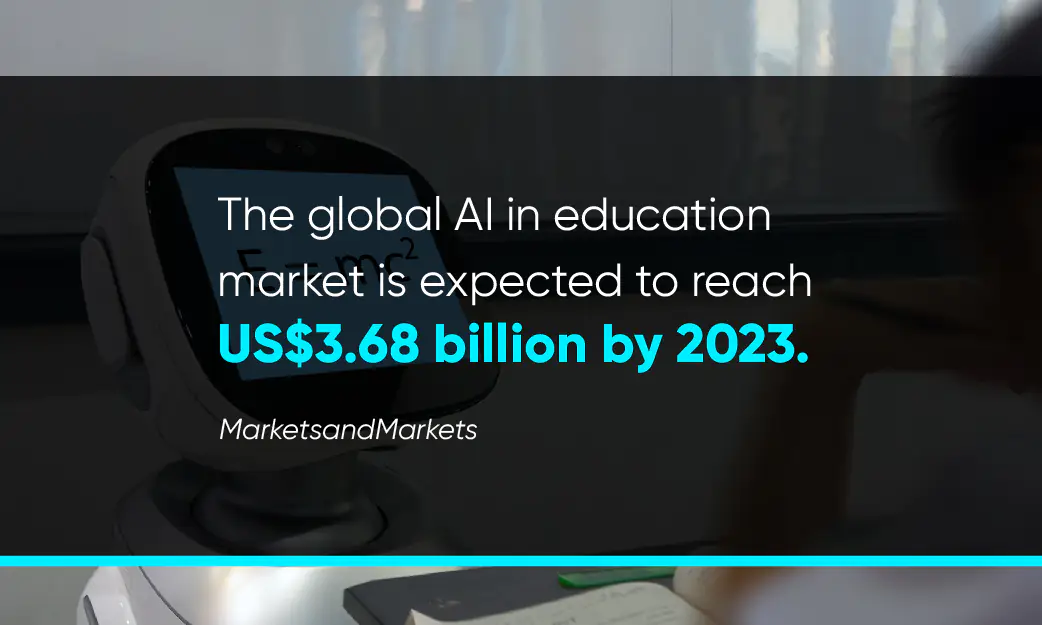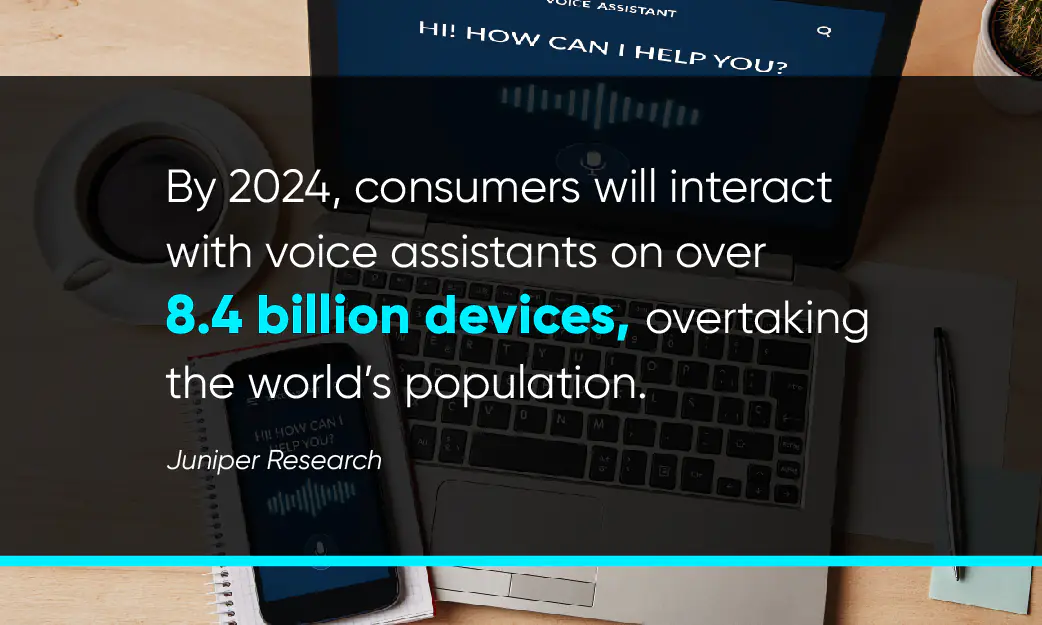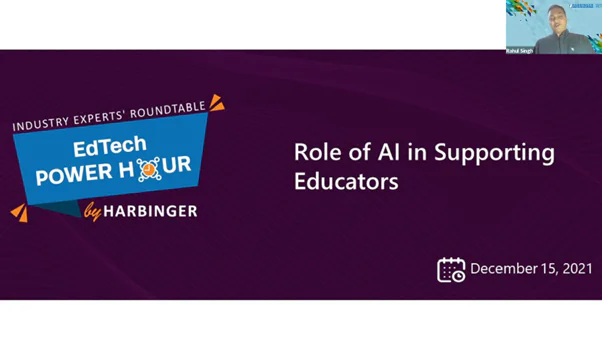
When most of us think about the role of artificial intelligence or AI in education, it often brings up images of robots teaching or learners interacting with software. But current developments in this space have a different story to narrate.
In education, AI is not about replacing teachers or educators with machines. It is a concept that blends technology with education in ways that benefit both educators and learners. It transforms the process of learning into a lot more responsive and interactive experience.
AI in education draws a significant amount of coverage as it innovates the way we learn quickly. It is a technology that is slowly taking over and becoming a part of our lives. Primarily deployed to provide personalized recommendations based on previous online patterns and behaviors, AI is now widely supporting the education sector.

How AI impacts the education sector
Before we learn about the impact of AI in education, let us understand what AI is and how it works.
AI works toward stimulating human intelligence processes by machines. Some specific applications of AI include natural language processing, speech recognition, hyper-personalized learning, voice assistance, customizable learning interfaces, and smart content creation.
AI in the education sector offers learners a personalized approach to learning programs. Besides, AI has the capability to adapt to individual student needs, based on their level of knowledge, speed of learning, and specific goals.
While we evaluate the role of AI in supporting educators, it is vital to take a closer look at the dropout rates across school systems. Going through these numbers will help you understand the gravity of the matter.
Over 31 million youth and young adults from upper-mid-income to high-income countries are not attending school. However, the good part is, as AI boosts educational experiences, upper secondary school graduation rates are expected to rise. This could result in lower unemployment and higher wages.
Furthermore, with the help of AI, more than 110 million students by 2040 hold a chance to receive additional support needed to complete upper secondary education. They are also expected to fill an additional 3.3 million jobs.
The global adoption of technology in the education space is changing the way knowledge is delivered and consumed. AI is a disruptive technology that customizes teaching and learning experiences and makes a difference to teachers, tutors, and learning groups. It has the potential to change learning experiences and deliver better student outcomes

What are the challenges to implementing AI in education?
AI has proved to be instrumental in developing novel teaching and learning solutions. Technology helps education systems deploy data to enhance educational equity and equality. The application of AI in EdTech is growing and uses advanced techniques like data mining, deep learning, and more to resolve complex learning issues.
Although AI is frequently adopted and used in the education sector, there are a few challenges that come along. Here are some major challenges that hinder the implementation and adoption of AI in the educational framework:
- Lack of reliable data
- All-inclusive AI policies
- Inclusion and equity in AI
- Preparing teachers for AI-powered education
The role of AI in transforming the learning experience
AI is one of the hottest EdTech trends to watch out for in 2022, and for a reason. The primary goal of delivering complete learning experience is to develop solutions that are engaging, personalized, and skills oriented. AI effectively impacts these aspects of learning and plays a key role in bridging the skills gap between industry and academia.
Here’s how AI can be applied to achieve better student outcomes:
1. Make learning personalized
AI is an excellent way to identify what students are good at and what they do not know. It helps build a personalized study schedule for learners based on their individual needs. This approach works great to close knowledge gaps and increase the learner’s efficiency.
2. Add value to task automation
We might not be aware, but a teacher’s administrative tasks like evaluating, grading, and replying to students are pretty time consuming.
However, AI can help teachers optimize these activities and give them more time to focus on delivering quality learning experiences. Importantly, it can allow them to reserve more time for having a direct interaction with students.
3. Focus on the student’s weaknesses
AI is a technology that complements the efforts of teachers. It enables teachers to identify topics that are not well understood by students.
For example, when a student misses a question or is not able to answer it, AI alerts the teacher. The information received helps teachers make notes on the topics they need to revisit. This not only improves student performance but also provides teachers with the best teaching practices.
4. Engage in smart content production
Video lectures, audiobooks, digitized guides, and video conference sessions are good examples of smart content used in education. Smart content promotes easy, collaborative, and faster learning and improves teaching methods. It comes with various benefits like low storage requirement, easy content navigation, 24×7 access and multiple user access to content, media-rich or mixed media content, etc.
Digital lessons: With the help of AI, it is possible to create a digital learning interface with options like digital textbooks, bite-sized lessons, study guides, and customization.
Information visualization: Information can be recognized and registered in different ways. New ways of perceiving information powered by AI are simulation, visualization, and web-based study environments.
Updating learning content: In addition to supporting information generation, AI in education helps upgrade content by periodically updating the information. AI can also customize information for different learning curves.
AI has opened a wealth of strategic opportunities for institutions to deliver personalized learning experiences. Furthermore, consider the pace at which the world of education is switching from textbooks to digitized materials or e-content. AI is really helping institutions automate and optimize teaching and learning activities.
Recently, EdTech experts shared their perspectives and experiences on the role of AI in supporting educators in one of Harbinger’s Power Hour episodes. The EdTech Power Hour session also gave a glimpse of products that can be successfully leveraged to resolve challenges around the skills gap.

It was hosted by Rahul Singh, Senior Director at Harbinger Group, and featured expert panelists Ahmed Naumaan, Ph.D., Professor at School of STEM, American Public University System, Michael Spencer, Chief Executive Officer at Global Expansion Strategies, Ulhas Bodhankar, Senior Director – Business Consulting at Harbinger Group, and Harsha Sukhrani, EdTech Solutions Specialist at Harbinger Group.
Watch the complete episode “Role of AI in Supporting Educators” on demand.





